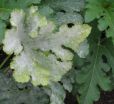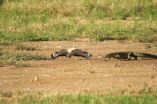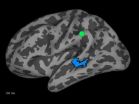(Press-News.org) A team of international researchers has uncovered a mechanism by which plants are able to better defend themselves against disease-causing pathogens.
The work, led by Dr Jurriaan Ton and Dr Estrella Luna at the University of Sheffield, has identified the key receptor binding a chemical called BABA (β-aminobutyric acid) which is boosting plant immunity.
BABA has long been known for its protective effects against devastating plant diseases, such as potato blight, but has so far not been used widely in crop protection because of undesirable side effects.
"We have found that the plant receptor binding BABA is an 'aspartyl tRNA synthetase' which we have called IBI1. This class of enzymes play a vital role in primary metabolism of all cells, but had never been linked to immune responses in plants," Dr Luna said.
"Binding of the chemical to this protein triggers a secondary function that 'primes' the plant immune system against future attacks by pests and diseases.
Dr Ton added: "Plant immunity that is controlled by a single resistance gene, on which most conventional breeding programs are based, is comparably easy to overcome by a pathogen.
"By contrast, priming of multi-genic immunity by BABA is difficult to break, thus offering more durable crop protection."
Dr Oliver Berkowitz, a Research Associate in the ARC Centre for Excellence in Plant Energy Biology and the School of Plant Biology at the University of Western Australia was also involved in the research.
"Importantly, our study also revealed that the undesirable side effect of this vaccination, a reduction in growth, can be uncoupled from the beneficial immune reaction," Dr Berkowitz said.
"Since plant immunisation by BABA is long-lasting, primed crops would require fewer applications of fungicides, thereby increasing sustainability of crop protection. Furthermore, immune priming boosts so-called 'multi-genic' resistance in plants."
Although their research has been performed in a weed called 'Arabidopsis thaliana', the work horse of plant geneticists, the team is confident that their discovery can be used for the protection of crops from their enemies. Proof-of-concept experiments have already shown that BABA is detected in a similar manner by tomato plants.
INFORMATION:
Scientists identify key receptor binding BABA chemical boosting plant immunity
BABA has been known for protecting plants against disease, but has so far not been widely used because of side effects
Findings will offer more durable crop protection
The research, which has been published in the international journal Nature Chemical Biology, also involved scientists from the University Jaume I in Spain and Utrecht University in The Netherlands.
Notes for Editors
The University of Sheffield
With nearly 25,000 of the brightest students from 117 countries coming to learn alongside 1,209 of the world's best academics, it is clear why the University of Sheffield is one of the UK's leading universities. Staff and students at Sheffield are committed to helping discover and understand the causes of things - and propose solutions that have the power to transform the world we live in.
A member of the Russell Group, the University of Sheffield has a reputation for world-class teaching and research excellence across a wide range of disciplines. The University of Sheffield has been named University of the Year in the Times Higher Education Awards 2011 for its exceptional performance in research, teaching, access and business performance. In addition, the University has won four Queen's Anniversary Prizes (1998, 2000, 2002, 2007), recognising the outstanding contribution by universities and colleges to the United Kingdom's intellectual, economic, cultural and social life.
One of the markers of a leading university is the quality of its alumni and Sheffield boasts five Nobel Prize winners among former staff and students. Its alumni have gone on to hold positions of great responsibility and influence all over the world, making significant contributions in their chosen fields.
Research partners and clients include Boeing, Rolls-Royce, Unilever, Boots, AstraZeneca, GSK, Siemens, Yorkshire Water and many more household names, as well as UK and overseas government agencies and charitable foundations.
The University has well-established partnerships with a number of universities and major corporations, both in the UK and abroad. The White Rose University Consortium (White Rose) a strategic partnership between three of the UK's leading research universities of Leeds, Sheffield and York. Since its creation in 1997 White Rose has secured more than £100M into the Universities.
For further information, please visit http://www.sheffield.ac.uk
Research finds a way to protect crops from pests and disease
2014-04-30
ELSE PRESS RELEASES FROM THIS DATE:
Robots may need to include parental controls
2014-04-30
Older adults' fears that companion robots will negatively affect young people may create design challenges for developers hoping to build robots for older users, according to Penn State researchers.
Companion robots provide emotional support for users and interact with them as they, for example, play a game, or watch a movie.
Older adults reported in a study that while they were not likely to become physically and emotionally dependent on robots, they worried that young people might become too dependent on them, said T. Franklin Waddell, a doctoral candidate in mass ...
Water-based 'engine' propels tumor cells through tight spaces in the body
2014-04-30
Johns Hopkins researchers have discovered a new mechanism that explains how cancer cells spread through extremely narrow three-dimensional spaces in the body by using a propulsion system based on water and charged particles.
The finding, reported in the April 24 issue of the journal Cell, uncovers a novel method the deadly cells use to migrate through a cancer patient's body. The discovery may lead to new treatments that help keep the disease in check. The work also points to the growing importance of studying how cells behave in three dimensions, not just atop flat two-dimensional ...
Frog eggs Help MU researchers find new information on grapevine disease
2014-04-30
COLUMBIA, Mo. – Vitis vinifera are common grapevines and are the world's favorite wine-producing varietal. However, research has shown that grapevines are susceptible to powdery mildew, a plant disease, which contributes to significant crop loss for most commercial wine varietals that are cultivated each year. Now, researchers at the University of Missouri have used frog eggs to determine the cause of this disease, and have found that a specific gene in the varietal Cabernet Sauvingon, contributes to its susceptibility.
"Powdery mildew disease causes the leaves of the ...
Predators predict longevity of birds
2014-04-30
This news release is available in German. Ageing inevitably occurs both in humans and in other animals. However, life-span varies widely across species. Researchers of the Max Planck Institute for Ornithology in Seewiesen have now found a possible general mechanism explaining differences in longevity. They investigated life history data of nearly 1400 bird species and found that avian life span varies considerably across the entire Earth, and that much of this variation can be explained by the species' body mass and clutch size and by the local diversity of predator ...
Your stress is my stress
2014-04-30
This news release is available in German. Stress is contagious. Observing another person in a stressful situation can be enough to make our own bodies release the stress hormone cortisol. This is the conclusion reached by scientists involved in a large-scale cooperation project between the departments of Tania Singer at the Max Planck Institute for Cognitive and Brain Sciences in Leipzig and Clemens Kirschbaum at the Technische Universität Dresden. Empathic stress arose primarily when the observer and stressed individual were partners in a couple relationship and the ...
A fattening gene
2014-04-30
This news release is available in German. The long-term consumption of too much high-energy and high-fat food leads to overweight. Behind this trivial statement lies the extremely complex regulation of lipid metabolism. Together with colleagues from Japan, scientists from the Max Planck Institute for Heart and Lung Research in Bad Nauheim have now discovered that the Sirt7 gene plays a central role in energy metabolism. Despite consuming high-fat food, genetically modified mice that lack the gene maintain their normal weight.
Food was not always available to such ...
In recognizing speech sounds, the brain does not work the way a computer does
2014-04-30
VIDEO:
Patterns of activation induced by listening to human speech move across brain hemispheres over a period of 300 milliseconds in these images, produced by combining data from EEG, MEG and...
Click here for more information.
How does the brain decide whether or not something is correct? When it comes to the processing of spoken language – particularly whether or not certain sound combinations are allowed in a language – the common theory has been that the brain applies a ...
Social media users need help to adjust to interface changes
2014-04-30
Social media companies that give users a greater sense of control can ease them into interface changes, as well as curb defections to competitors, according to researchers.
"Several studies have looked into how social media companies have failed," said Pamela Wisniewski, a post-doctoral scholar in information sciences and technology, Penn State. "What we need to think about is how social media companies can be more adaptive and how they can improve the longevity of their sites.
In a study of the reaction to the introduction of Facebook's Timeline interface between 2011 ...
Parents just as likely to use cell phones while driving, putting child passengers at risk
2014-04-30
Ann Arbor, Mich. — Despite their precious cargo, parents are no less likely to engage in driving distractions like cell phone use than drivers from the general population, according to a new University of Michigan study published in
Academic Pediatrics.
The study found that 90 percent of parent drivers said they engaged in at least one of the 10 distractions examined in the study while their child was a passenger and the vehicle was moving, says lead author Michelle L. Macy, M.D., M.S., an emergency medicine physician at the University of Michigan's C.S. Mott Children's ...
Study questions Neandertal inferiority to early modern humans
2014-04-30
The embargo has been lifted for the article, 'Neandertal Demise: An Archaeological Analysis of the Modern Human Superiority Complex.'
An analysis of the archaeological records of Neandertals and their modern human contemporaries has found that complex interbreeding and assimilation may have been responsible for Neandertal disappearance 40,000 years ago, in contrast to many current theories, according to results published April 30, 2014, in the open access journal PLOS ONE by Paola Villa from the University of Colorado Museum and Wil Roebroeks from Leiden University ...




